The 25 Most Unimaginable Torture Devices
Ever Created
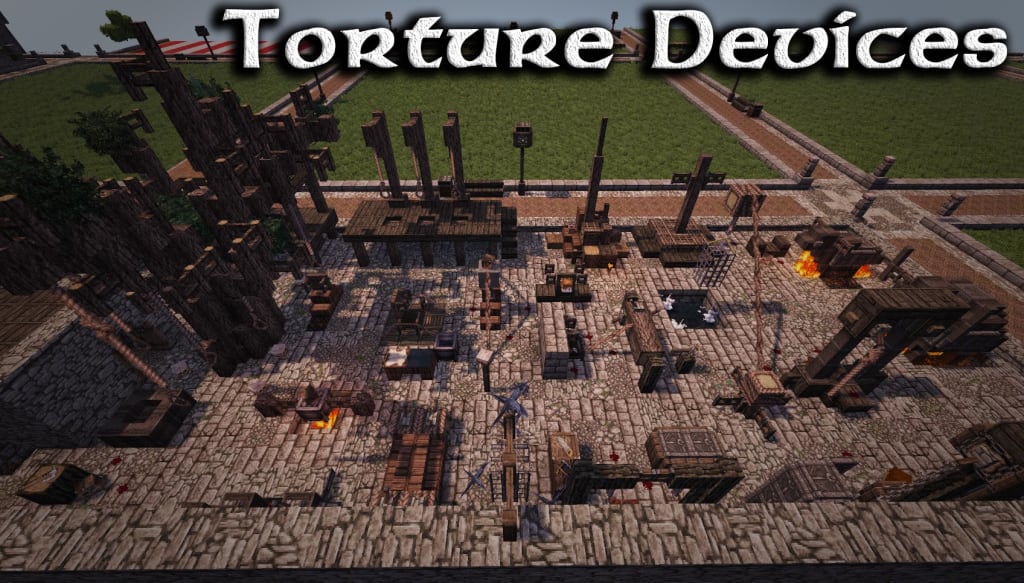
During Medieval Times, mainly nobles and royalty had pretty much power over men and society at large. Although when it came to "justice" it wasn't any different. Most people with low resources such as peasants, labor workers, and farmers, had little to no rights when it came down to the "law".
The dark age torturers and executioners that created these devices, were really imaginative when it came down to torturing others and apparently it paid off because millions of people suffered the unimaginable when it came to their deaths. Most of them highly painful and very slow, while others were used as means of interrogation.
Unfortunately, thousands upon thousands of people died when these devices were put to use, but the ones that didn't still suffered a great amount of pain and were scarred for life. Next, I've compiled a list of the 25 worst medieval torture devices.
NOTE: NOT ALL torture devices are listed here.
1.- SAW TORTURE
In this method, the victim is hung upside down, so that the blood will rush to their heads and keep them conscious during the long torture. The torturer would then saw through the victims’ bodies until they were completely sawed in half. Most were cut up only in their abdomen to prolong their agony.

2.- THE CHAIR OF TORTURE
Also known as the Judas Chair, it was a terrible, intimidating torture device that was added to dungeons in the Middle Ages. Used until the 1800′s in Europe, this chair was layered with 500 to 1,500 spikes on every surface with tight straps to restrain its victim. Made of iron, it can also contain spaces for heating elements beneath the seat. It was often used to scare people into giving confessions as they watched others being tortured on the device.
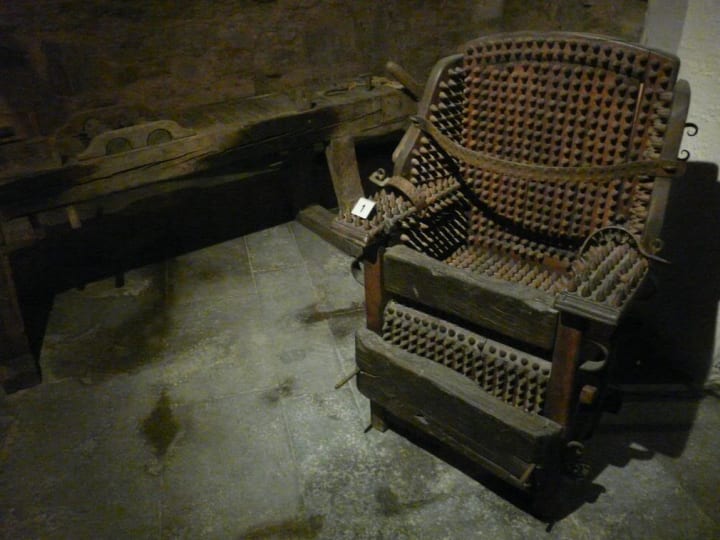
3.- THE RACK
Is a torture device consisting of a rectangular, usually wooden frame, slightly raised from the ground, with a roller at one or both ends. The victim's ankles are fastened to one roller and the wrists are chained to the other. As the interrogation progresses, a handle and ratchet mechanism attached to the top roller is used to very gradually increase the tension on the chains, inducing excruciating pain. By means of pulleys and levers, this roller could be rotated on its own axis, thus straining the ropes until the sufferer's joints were dislocated and eventually separated. Additionally, if a muscle is stretched excessively, they lose their ability to contract, rendering them ineffective. One gruesome aspect of being stretched too far on the rack is the loud popping noises made by snapping cartilage, ligaments or bones.

4.- THE BREAST RIPPER
Known in another form as the Iron Spider or simply the spider, was a torture instrument mainly used on women who were accused of adultery, or self-abortion. The instrument was designed to rip the breasts from a woman and was made from iron, which was usually heated. The tool was used popularly in the Free State of Bavaria, a state in Germany, in 1599, and in parts of Germany and France until the nineteenth century.
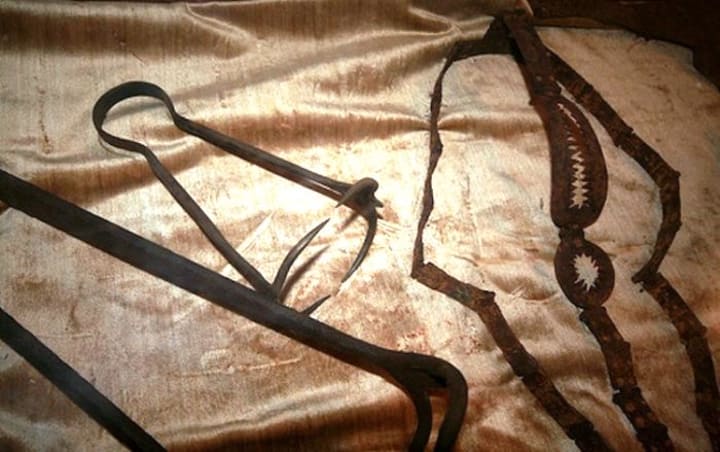
5.- TONGUE TEARER
Looking like an oversized pair of scissors, it could effortlessly cut the victim’s tongue. Their mouth would be forced open with a device called a mouth opener, and then the iron tongue tearer would uncomfortably twitch the tongue with its rough grippers. Once a firm hold was maintained, the screw would be firmly tightened and the victim’s tongue would roughly be torn out.
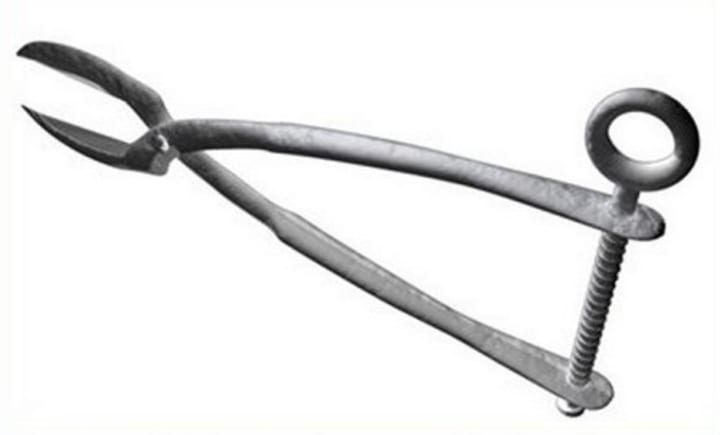
6.- THE IRON MAIDEN
This torture device consisted of an iron cabinet with a hinged front and spike-covered interior, sufficient enough to enclose a human being. Once inside its conical frame, the victim would be unable to move due to the great number of steel spikes impaling them from every direction. The interrogator would scream questions at the victim while poking them with jagged edges.
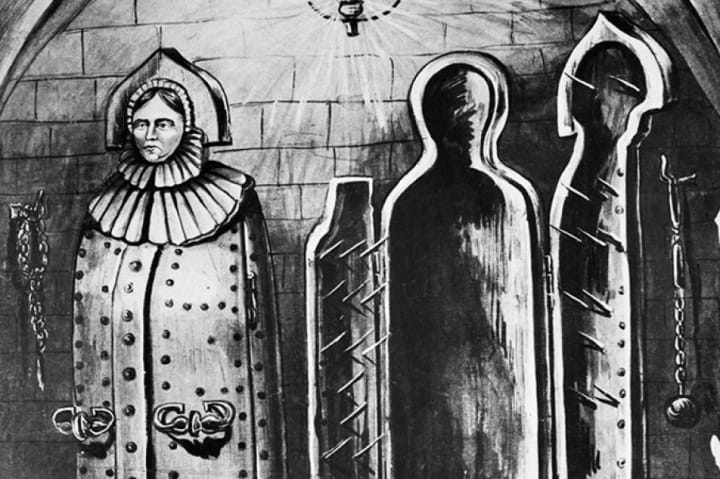
7.- GUILLOTINE
One of the most notorious forms of executions, the guillotine was made of a razor sharp blade attached to a rope. The victim’s head was placed in the middle of the frame as the blade dropped, severing the victim’s head from the body. Since the decapitation was considered to be an instant and painless event (at least less painful than the other torture methods), it was often considered the most humane method of execution.
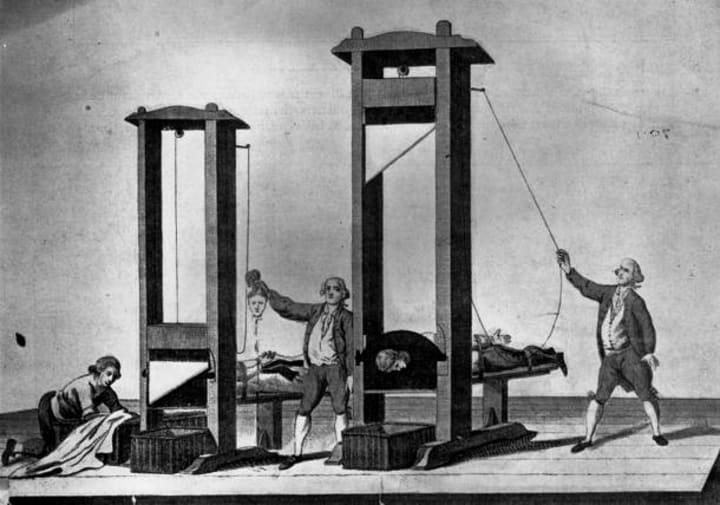
8.- THE BRAZEN BULL
Also known as the Sicilian Bull, it was designed in ancient Greece. A solid piece of brass was cast with a door on the side that could be opened and latched. The victim would be placed inside the bull and a fire set underneath it until the metal became literally yellow as it was heated. The victim would then be slowly roasted to death all while screaming in agonizing pain. The bull was purposely designed to amplify these screams and make them sound like the bellowing of a bull.

9.- BOOT
The term boot refers to a family of instruments of torture and interrogation variously designed to cause crushing injuries to the foot and/or leg. The boot has taken many forms in various places and times. Common varieties include the Spanish boot and the Malay boot. One type was made of four pieces of narrow wooden board nailed together. The boards were measured to fit the victim's leg. Once the leg was enclosed, wedges would be hammered between the boards, creating pressure. The pressure would be increased until the victim confessed or lost consciousness. Newer variants have included iron vises, sometimes armed with spikes that squeezed feet and metal frames employed red hot.
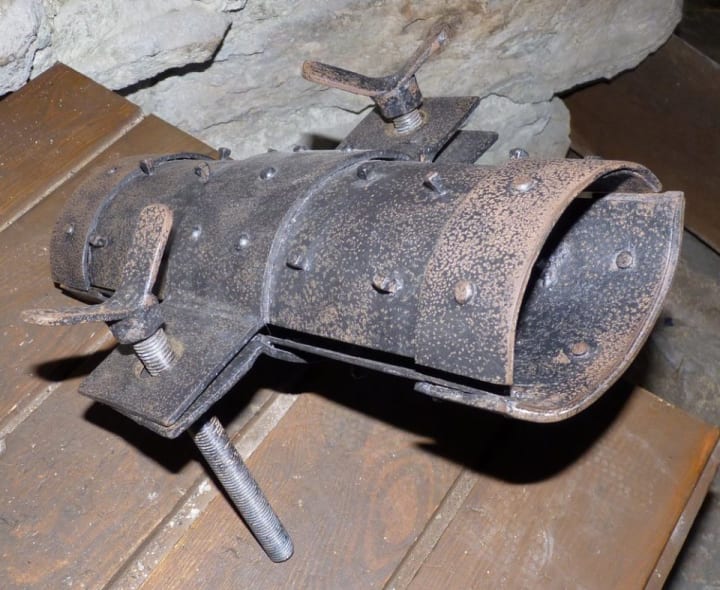
10.- HANGED, DRAWN AND QUARTERED
During medieval times, the penalty for high treason in England was to be hanged, drawn and quartered in public and though it was abolished in 1814, it has been responsible for the death of thousands of people. In this torture technique, the victim is dragged in a wooden frame called a hurdle to the place of execution. They would then be hanged by the neck for a short period of time until they are near-death (hanged), followed by disembowelment and castration where the entrails and genitalia are burned in front of the victim (drawn). The victim would then be divided into four separate parts and beheaded (quartered).

11.- STRAPPADO
The Strappado is a form of torture in which the victim's hands are first tied behind his or her back and suspended in the air by means of a rope attached to wrists, which most likely dislocates both arms. Weights may be added to the body to intensify the effect and increase the pain. Other names for strappado include "reverse hanging" and "Palestinian hanging" (although it is not used by the Palestinian Authority) It is best known for its use in the torture chambers of the medieval inquisition.
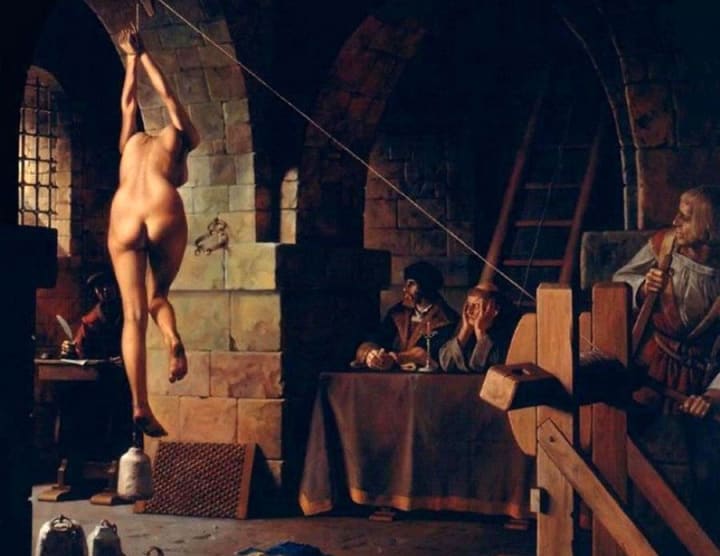
12.- WOODEN HORSE/SPANISH DONKEY
One of the torture devices during the Spanish Inquisition and medieval ages, this is probably one of the most gruesome of them all. The victim has put astride, naked, on a donkey-like apparatus, which is actually a vertical wooden board with a sharp V-wedge on top of it. After that, the torturer would add varying weights to the victim’s feet until finally, the wedge sliced through the victim’s body.

13.- PEAR OF ANGUISH/CHOKE PEAR
The pear of anguish or choke pear is the modern name for a type of instrument displayed in some museums, consisting of a metal body (usually pear-shaped) divided into spoon-like segments that could be spread apart by turning a screw. The museum descriptions and some recent sources assert that the devices were used either as a gag, to prevent people from speaking, or internally as an instrument of torture.

14.- JUDAS CRADLE
The victim would presumably be placed in the waist harness above the pyramid-shaped seat, with the point inserted into their an*s or v*gin*, then very slowly lowered by ropes. The subject is tortured by intense pressure and stretching of the orifice, eventually succumbing to tears in muscle tissue that could turn septic and kill from infection, or simply being impaled.

15.- CRUCIFIXION
Principally practiced in antiquity, though it remains practiced in some countries today; it is one of the most well-known execution methods due to the crucifixion of Jesus Christ. It is a deliberately slow and painful execution where the condemned person is tied or nailed to a large wooden cross and left to hang until they die, which usually takes days.

16.- NECK TORTURE
Humiliating and painful, this punishment was something of an endurance test where the victim would be hooked into a neck device, either made of metal or wood, which prevented the victim from adjusting into a comfortable position. The cruelty of this punishment lies within the fact that they were unable to lie down, eat, or lower their head for days.
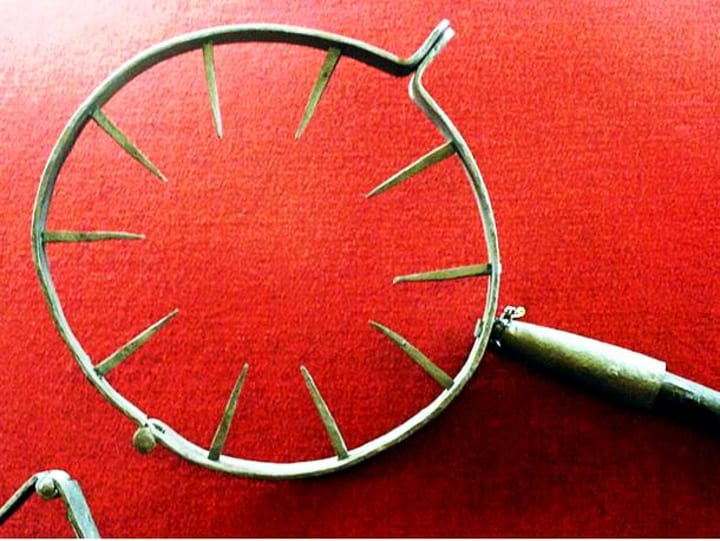
17.- HERETIC'S FORK
The device was placed between the breastbone and throat just under the chin and secured with a leather strap around the neck, while the victim was hung from the ceiling or otherwise suspended in a way so that they could not lie down.Usually, the Heretic's fork was given to people who spoke the Lord's name in vain, blasphemers, or liars. This way, the punishment made it nearly impossible for them to talk. Also, a person wearing it couldn't fall asleep. The moment their head dropped with fatigue, the prongs pierced their throat or chest, causing great pain. This very simple instrument created long periods of sleep deprivation. People were awake for days, which made confessions more likely.
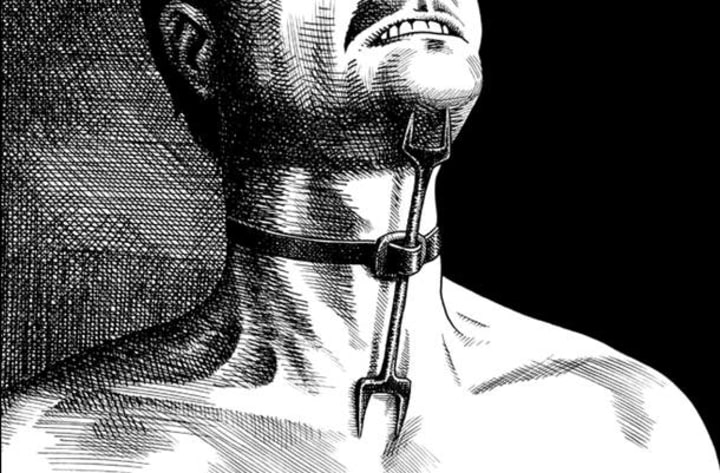
18.- BREAKING WHEEL/ CATHERINE WHEEL
Was a torture device used for capital punishment from Antiquity into early modern times for public execution by breaking the criminal's bones/bludgeoning him to death. As a form of execution, it was used from "Classical" times into the 18th century; as a form of post-mortem punishment of the criminal, the wheel was still in use in 19th century Germany.
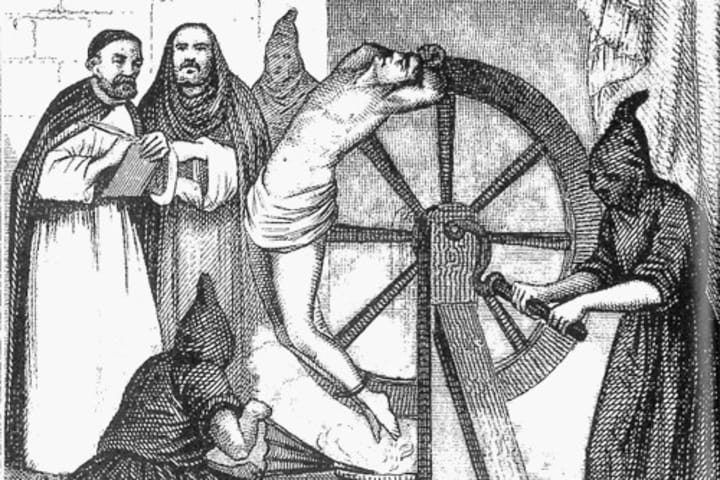
19.- SHREW'S FIDDLE/ NECK VIOLIN
Is a form of rigid irons whereby the wrists are locked in front of the bound person by a hinged board or steel bar. It was originally used in the 18th century as a way of punishing women who were caught bickering or fighting.

20.- COFFIN TORTURE
The most preferred torture technique in the Middle Ages was known as coffin torture. This method involved placing the victim inside a metal cage roughly the size of the human body; hence the name. The torturers also forced overweight victims into smaller cages to heighten their discomfort as they hung from a tree or gallows. Generally, they would be left there until the crows came to feed on their remains.

21.- SPANISH TICKLER/ CAT'S PAW
Is a type of torture instrument, consisting of long, sharp iron spikes curved so as to resemble claws. It was often attached to a handle, or else used as an extension of the torturer's hand. In this way, it was used to rip and tear flesh away from the bone, from any part of the body. It was also used as a weapon. This device was commonly used on thieves and unfaithful wives. Most who were tortured in this manner died not at the time, but afterward. Especially with the Cat’s Paw, the device would cause infections as the device would cut so deep. The prongs were nearly never washed, so the chances of these infections were very high.

22.- KNEE SPLITTER
The knee splitter was a form of torture used mainly during the inquisition. It was created from two spiked wood blocks, placed in front of, and behind the knee. The blocks were connected with two large screws. When turned, the blocks would close towards each other, destroying the knee underneath them. This method was used to render the knees useless. The number of spikes on the blocks would range from three to twenty, depending on the captive.

23.- HEAD CRUSHER
This metal device featured a plate that sat below the victim's jaw, which was connected by a frame to the head cap. As the torturer slowly twisted the handle, the gap between the head cap and plate decreased in width, causing crushing of the skull and facial bones, including teeth and jaws, and ultimately inducing death; even if the torturer stopped before death, permanent damage to the facial muscles and structure would occur. The victim's head would slowly be crushed, killing the victim, but not before the victim's jaw had been crushed, and their eyes had popped from their socket.

24.- THUMBSCREW/ PILLIWINKS
Is a torture instrument which was first used in medieval Europe. It is a simple vice, sometimes with protruding studs on the interior surfaces. The victim's thumbs or fingers were placed in the vice and slowly crushed. The thumbscrew was also applied to crush prisoners' big toes. The crushing bars were sometimes lined with sharp metal points to puncture the thumbs and inflict greater pain in the nail beds. Larger, heavier devices based on the same design principle were applied to crush feet and ears.

25.- IMPALEMENT
Given his name, it should come as no surprise that this was the most favored method of execution by Vlad the Impaler. In 15th century Romania; the victim was forced to sit on a sharp and thick pole. When the pole was then raised upright, the victim was left to slide down the pole with their own weight. It could take the victim 3 days to die using this method and it has been said that Vlad once did this to 20,000 people all while enjoying a meal.

Did these devices give you chills just thinking about them? Thank goodness we don't live in those ages anymore, although, some of these torture methods are said that they STILL occur in some places around the world.
In the meantime don't forget to FOLLOW ME and share this article. Stay tuned for more creepy and scary content. Wanna chat about horror? Drop me a line or follow me on my social media pages, until next time... Sweet Screams.
About the Creator
Rain- Screaming for Horror
Writer and Horror Geek at VM. Like,Follow & Subscribe to our social media pages at:
Screaming for Horror on Youtube
Screaming for Horror on Facebook
Screaming for Horror on Tiktok
Screaming for Horror on Spotify





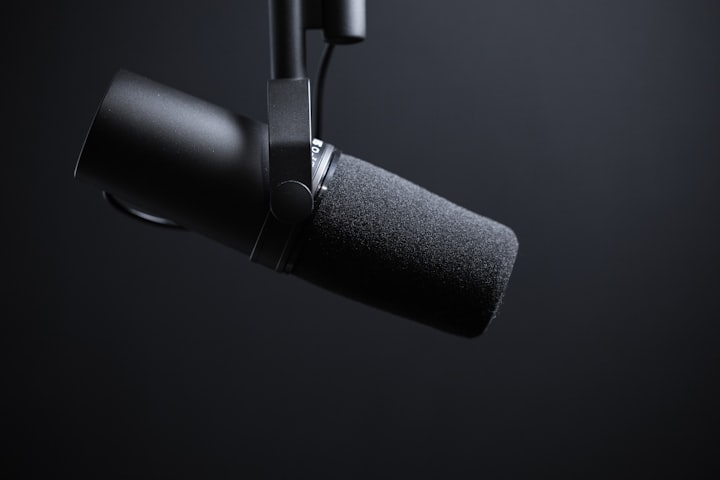

Comments
There are no comments for this story
Be the first to respond and start the conversation.